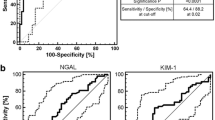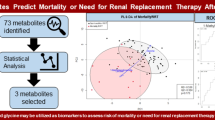Abstract
Acute kidney injury (AKI) is a frequent complication of sepsis, major surgery or nephrotoxic medication use. It is associated with high morbidity and mortality. In an effort to identify novel biomarkers capable of predicting the development of AKI after cardiac surgery with cardiopulmonary bypass use, urine specimens were collected before and at 4 and 24 h after surgery from 106 patients and analyzed by means of nuclear magnetic resonance spectroscopy. Postoperative AKI of stage 1–3 as defined by the Acute Kidney Injury Network (AKIN) developed in 34 cases. Employing Quantile Normalization and support vector machine based classification, spectra of the 24-hour postoperative urine specimens were found to predict AKI across all stages with an average accuracy of 76.0 % and a corresponding area under the receiver operating characteristic curve of 0.83. Considering only AKIN-stage 2 and 3 patients, prediction accuracy increased to 81.7 % and 100 %, respectively. Among the small set of predictive biomarkers identified was carnitine, the urinary concentration of which was elevated significantly in AKI-free patients only, and tranexamic acid, which is routinely applied as an antifibrinolytic agent at the end of surgery, and whose renal excretion was delayed in AKI patients. The study underscores the power of NMR and bioinformatics in identifying novel biomarkers of disease and in gaining new insights into pathomechanisms.




Similar content being viewed by others
References
Al-Shabanah, O. A., Aleisa, A. M., Al-Yahya, A. A., et al. (2010). Increased urinary losses of carnitine and decreased intramitochondrial coenzyme A in gentamicin-induced acute renal failure in rats. Nephrology, Dialysis, Transplantation, 25, 69–76.
Arduini, A., Bonomini, M., Savica, V., Amato, A., & Zammit, V. (2008). Carnitine in metabolic disease: Potential for pharmacological intervention. Pharmacology & Therapeutics, 120, 149–156.
Bellomo, R., Ronco, C., Kellum, J. A., Mehta, R. L., Palevsky, P., & ADQI Workgroup. (2004). Acute renal failure-definition, outcome measures, animal models, fluid therapy and information technology needs: The second international consensus conference of the acute dialysis quality initiative (ADQI) group. Critical Care, 8(4), R204–R212.
Benjamini, Y., & Hochberg, Y. (1995). Controlling the false discovery rate: A practical and powerful approach to multiple testing. Journal of the Royal Statistical Society B, 57, 289–300.
Bolstad, B. M., Irizarry, R. A., Astrand, M., & Speed, T. P. (2003). A comparison of normalization methods for high density oligonucleotide array data based on variance and bias. Bioinformatics, 19, 185–193.
Braga-Neto, U. M., & Dougherty, E. R. (2004). Is cross-validation valid for small-sample microarray classification? Bioinformatics, 20, 374–380.
Ciba-Geigy. (1983). Wissenschaftliche Tabellen Geigy. Basel: Ciba-Geigy.
Devchand, P. R., Keller, H., Peters, J. M., Vazquez, M., Gonzalez, F. J., & Wahli, W. (1996). The PPAR alpha-leukotriene B4 pathway to inflammation control. Nature, 384, 39–43.
Diao, L., Ekins, S., & Polli, J. E. (2010). Quantitative structure activity relationship for inhibition of human organic cation/carnitine transporter. Molecular Pharmaceutics, 7, 2120–2131.
Dzúrik, R., Spustová, V., Krivosíková, Z., & Gazdíková, K. (2001). Hippurate participates in the correction of metabolic acidosis. Kidney International Supplement, 78, S278–S281.
Endre, Z. H., Pickering, J. W., Walker, R. J., et al. (2011). Improved performance of urinary biomarkers of acute kidney injury in the critically ill by stratification for injury duration and baseline renal function. Kidney International, 79, 1119–1130.
Eriksson, O., Kjellman, H., Pilbrant, A., & Schannong, M. (1974). Pharmacokinetics of tranexamic acid after intravenous administration to normal volunteers. European Journal of Clinical Pharmacology, 7, 375–380.
Fukui, Y., Kato, M., Inoue, Y., Matsubara, A., & Itoh, K. (2009). A metabonomic approach identifies human urinary phenylacetylglutamine as a novel marker of interstitial cystitis. Journal of Chromatography B, 877, 3806–3812.
Ganapathy, M. E., Huang, W., Rajan, D. P., et al. (2000). Beta-lactam antibiotics as substrates for OCTN2, an organic cation/carnitine transporter. Journal of Biological Chemistry, 275, 1699–1707.
Geng, W., & Pang, K. S. (1999). Differences in excretion of hippurate, as a metabolite of benzoate and as an administered species, in the single-pass isolated perfused rat kidney explained. Journal of Pharmacology and Experimental Therapeutics, 288, 597–606.
Gronwald, W., Klein, M. S., Kaspar, H., et al. (2008). Urinary metabolite quantification employing 2D NMR spectroscopy. Analytical Chemistry, 80, 9288–9297.
Gronwald, W., Klein, M. S., Zeltner, R., et al. (2011). Detection of autosomal dominant polycystic kidney disease by NMR spectroscopic fingerprinting of urine. Kidney International, 79, 1244–1253.
Haase-Fielitz, A., Mertens, P. R., Plass, M., et al. (2011). Urine hepcidin has additive value in ruling out cardiopulmonarybypass-associated acute kidney injury: An observational cohort study. Critical Care, 15, R186.
Han, W. K., Bailly, V., Abichandani, R., Thadhani, R., & Bonventre, J. V. (2002). Kidney injury molecule-1 (KIM-1): A novel biomarker for human renal proximal tubule injury. Kidney International, 62, 237–244.
Han, W. K., Wagener, G., Zhu, Y., Wang, S., & Lee, H. T. (2009). Urinary biomarkers in the early detection of acute kidney injury after cardiac surgery. Clinical Journal of the American Society of Nephrology, 4, 873–882.
Harvey, P. W., & Everett, D. J. (2004). Significance of the detection of esters of P-hydroxybenzoic acid (parabens) in human breast tumours. Journal of Applied Toxicology, 24, 1–4.
Idrovo, J.-P., Yang, W.-L., Matsuda, A., Nicastro, J., Coppa, G. F., & Wang, P. (2012). Post-treatment with the combination of 5-aminoimidazole-4-carboxyamide ribonucleoside and carnitine improves renal function after ischemia/reperfusion injury. Shock, 37, 39–46.
Itoh, Y., Ezawa, A., Kikuchi, K., Tsuruta, Y., & Niwa, T. (2012). Protein-bound uremic toxins in hemodialysis patients measured by liquid chromatography/tandem mass spectrometry and their effects on endothelial ROS production. Analytical and Bioanalytical Chemistry, 403, 1841–1850.
James, M. O., Smith, R. L., Williams, R. T., & Reidenberg, M. (1972). The conjugation of phenylacetic acid in man, sub-human primates and some non-primate species. Proceedings of the Royal Society of London B: Biological Sciences, 182, 25–35.
Kang, S.-M., Park, J.-C., Shin, M.-J., et al. (2011). ¹H nuclear magnetic resonance based metabolic urinary profiling of patients with ischemic heart failure. Clinical Biochemistry, 44, 293–299.
KDIGO Workgroup. (2012). Section 2: AKI definition. Kidney International Supplement, 2, 19–36.
Klein, M. S., Almstetter, M. F., Schlamberger, G., et al. (2010). Nuclear magnetic resonance and mass spectrometry-based milk metabolomics in dairy cows during early and late lactation. Journal of Dairy Science, 93, 1539–1550.
Kohl, S. M., Klein, M. S., Hochrein, J., Oefner, P. J., Spang, R., & Gronwald, W. (2012). State-of-the art data normalization methods improve NMR-based metabolomic analysis. Metabolomics, 8, 146–160.
Kostka, D., & Spang, R. (2008). Microarray based diagnosis profits from better documentation of gene expression signatures. PLoS Computational Biology, 4, e22.
Lameire, N. H., Vanholder, R. C., & Biesen, W. A. V. (2011). How to use biomarkers efficiently in acute kidney injury. Kidney International, 79, 1047–1050.
Lango, R., Smolenski, R. T., Rogowski, J., et al. (2005). Propionyl-l-carnitine improves hemodynamics and metabolic markers of cardiac perfusion during coronary surgery in diabetic patients. Cardiovascular Drugs and Therapy, 19, 267–275.
Lemberger, T., Desvergne, B., & Wahli, W. (1996). Peroxisome proliferator-activated receptors: A nuclear receptor signaling pathway in lipid physiology. Annual Review of Cell and Developmental Biology, 12, 335–363.
Liu, Y., Yan, S., Ji, C., et al. (2012). Metabolomic changes and protective effect of (l)-carnitine in rat kidney ischemia/reperfusion injury. Kidney and Blood Pressure Research, 35, 373–381.
Lohninger, A., Pittner, G., & Pittner, F. (2005). l-Carnitine: New aspects of a known compound-a brief survey. Monatshefte Chemie, 136, 1255–1268.
Mariscalco, G., Lorusso, R., Dominici, C., Renzulli, A., & Sala, A. (2011). Acute kidney injury: A relevant complication after cardiac surgery. Annals of Thoracic Surgery, 92, 1539–1547.
Mehta, R. L., Kellum, J. A., Shah, S. V., et al. (2007). Acute kidney injury network: Report of an initiative to improve outcomes in acute kidney injury. Critical Care, 11, R31.
Mukherjee, S., Golland, P., & Panchenko, P. (2003). Permutation tests for classification. Cambridge: Massachusetts Institute of Technology.
Noiri, E., Yokomizo, T., Nakao, A., et al. (2000). An in vivo approach showing the chemotactic activity of leukotriene B(4) in acute renal ischemic-reperfusion injury. Proceedings of the National Academy of Sciences USA, 97, 823–828.
Parikh, C. R., Abraham, E., Ancukiewicz, M., & Edelstein, C. L. (2005). Urine IL-18 is an early diagnostic marker for acute kidney injury and predicts mortality in the intensive care unit. Journal of the American Society of Nephrology, 16, 3046–3052.
Portilla, D., Dai, G., Peters, J. M., Gonzalez, F. J., Crew, M. D., & Proia, A. D. (2000). Etomoxir-induced PPARalpha-modulated enzymes protect during acute renal failure. American Journal of Physiology: Renal Physiology, 278, F667–F675.
Psychogios, N., Hau, D. D., Peng, J., et al. (2011). The human serum metabolome. PLoS One, 6, e16957.
Rosner, M. H., & Okusa, M. D. (2006). Acute kidney injury associated with cardiac surgery. Clinical Journal of the American Society of Nephrology, 1, 19–32.
Selma, M. V., Espín, J. C., & Tomás-Barberán, F. A. (2009). Interaction between phenolics and gut microbiota: Role in human health. Journal of Agricultural and Food Chemistry, 57, 6485–6501.
Shaw, A., Swaminathan, M., & Stafford-Smith, M. (2008). Cardiac surgery-associated acute kidney injury: Putting together the pieces of the puzzle. Nephron Physiology, 109, 55–60.
Sing, T., Sander, O., Beerenwinkel, N., & Lengauer, T. (2005). ROCR: Visualizing classifier performance in R. Bioinformatics, 21, 3940–3941.
Star, R. A. (1998). Treatment of acute renal failure. Kidney International, 54, 1817–1831.
van de Poll, M. C. G., Soeters, P. B., Deutz, N. E. P., Fearon, K. C. H., & Dejong, C. H. C. (2004). Renal metabolism of amino acids: Its role in interorgan amino acid exchange. American Journal of Clinical Nutrition, 79, 185–197.
van Vlies, N., Ferdinandusse, S., Turkenburg, M., Wanders, R. J. A., & Vaz, F. M. (2007). PPAR alpha-activation results in enhanced carnitine biosynthesis and OCTN2-mediated hepatic carnitine accumulation. Biochimica et Biophysica Acta, 1767, 1134–1142.
Varma, S., & Simon, R. (2006). Bias in error estimation when using cross-validation for model selection. BMC Bioinformatics, 7, 91.
Vaz, F. M., & Wanders, R. J. A. (2002). Carnitine biosynthesis in mammals. Biochemical Journal, 361, 417–429.
Waikar, S. S., Sabbisetti, V. S., & Bonventre, J. V. (2010). Normalization of urinary biomarkers to creatinine during changes in glomerular filtration rate. Kidney International, 78, 486–494.
Westhuyzen, J., Endre, Z. H., Reece, G., Reith, D. M., Saltissi, D., & Morgan, T. J. (2003). Measurement of tubular enzymuria facilitates early detection of acute renal impairment in the intensive care unit. Nephrology, Dialysis, Transplantation, 18, 543–551.
Acknowledgments
The data of this study has been deposited to the MetaboLights repository (URL: http://www.ebi.ac.uk/metabolights/MTBLS24). This study was supported in part by the Bavarian Genomic Network (BayGene), the German Federal Ministry of Education and Research (BMBF Grant no. 01 ER 0821), and the intramural funding program of the Regensburg School of Medicine. The authors are grateful to Drs. Claudio Lottaz, Inka Appel, and Rainer Spang for helpful discussions regarding statistics.
Author information
Authors and Affiliations
Corresponding author
Additional information
Helena U. Zacharias and Gunnar Schley contributed equally to this study.
Electronic supplementary material
Below is the link to the electronic supplementary material.
Rights and permissions
About this article
Cite this article
Zacharias, H.U., Schley, G., Hochrein, J. et al. Analysis of human urine reveals metabolic changes related to the development of acute kidney injury following cardiac surgery. Metabolomics 9, 697–707 (2013). https://doi.org/10.1007/s11306-012-0479-4
Received:
Accepted:
Published:
Issue Date:
DOI: https://doi.org/10.1007/s11306-012-0479-4




